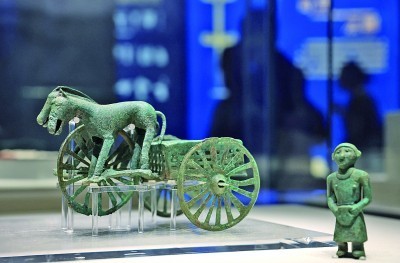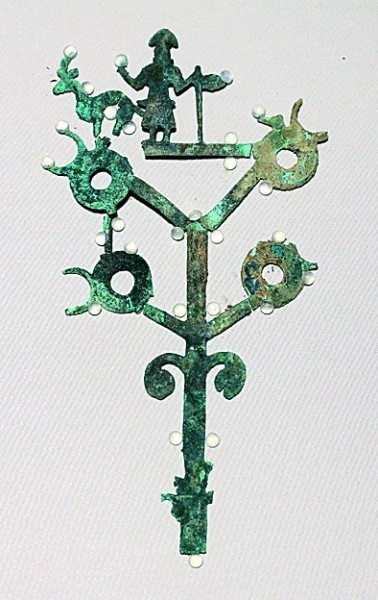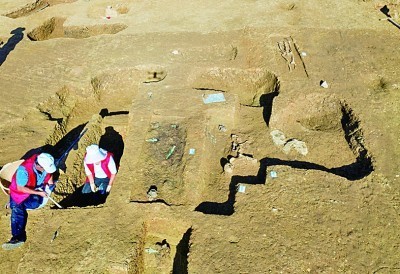"Bronze Kingdom" is now Sichuan again
Author:Guangming Daily Time:2022.06.20

Copper car and horse and copper people information pictures

Bronze branches information picture

Tao Shuang ear can information picture

Copper clock information picture

Waist cubic copper decoration information picture

Archaeological excavation site information pictures
On June 18, the first academic seminar on the interaction and exchanges of various ethnic groups in Yanyuan Culture was held in Yanyuan County, Liangshan Prefecture, Sichuan Province. According to the seminar, more than 1,100 tombs from the late business generation to the early Western Han Dynasty were cleaned again, and more than 5,000 various relics were unearthed to the world, showing the world showing that Sichuan after Sanxingdui and the Sands ruins to the world again and again. A unique "bronze kingdom".
The Yanyuan Basin, which is located in the deep mountains southwest of Sichuan, is an important node on the cultural exchanges and crowd migration channels in the east and south of the east of Qinghai -Tibet Plateau. The special geographical and cultural location makes the ancient culture of the region present a diverse and compound characteristics.
Since 1987, the Chengdu Institute of Cultural Relics and Archeology, the Sichuan Provincial Institute of Cultural Relics and Archeology, the Liangshan Yi Autonomous Prefecture Museum, and the Yanyuan County Cultural Relics Management Institute have carried out four rescue excavations on the old leader sites. Among them, the fourth excavation began in April 2020, and important progress has been made, and the mysterious veil of the "bronze kingdom" in southwestern Sichuan has been unveiled.
From the Shang Dynasty to the Western Han Dynasty, it can be used as the ruler of the Bronze Age of Southwest Sichuan
The burial method of the old leader's cemetery is all the earthen hole tombs except the coffin. The burial type is common in straight limbs, and a small amount of flexion and amputation; large and medium -sized tombs include coffin, small tombs, and only coffins, and some tombs have no coffin marks; most of them have funerals, varying.
Tian Jianbo, the person in charge of the Archaeological excavation site of the Yanyuan Site of the Chengdu Cultural Relics and Archeology Research Institute, said that according to the unexplained utensils and the existing annual measurement data, the tombs of the old leader site can be initially divided into three phases.
The first phase was the Shang to the Western Zhou Dynasty, and the main body was the Western Zhou Dynasty. The shape of the tomb includes a narrow -length square pits and earthen hole tombs and coffin tombs. There are no wooden funerals in the tombs of the earthen pits. The copper wares in the burial utensils are extremely rare, and only a small number of arrows are seen. The unearthed pottery is mainly milk nails, sturgeon beans, flowers, tall cans, and small double -ear cans. The types of unearthed utensils are relatively single. In addition, there are also stone tools such as knives, arrows, and stitches.
The second phase is the Spring and Autumn Period. The tomb is mainly based on the rectangular pits, and most of them have wooden funerals. The burial utensils are mainly copper, pottery and stone. The bronze is dominated by swords and Ge, especially with the most characteristic of swords. The pottery is mainly small -ear tanks and high -necked tanks. The ears have a large double -ear can from the mouth to the middle of the abdomen, and a small amount of flowing pot is produced.
The third phase is the Warring States Period to the early Western Han Dynasty. The tomb includes a narrow -length square -shaped vertical hole tomb and a wide square pits with a large square pits with a roof of the top stone. The scale of the tomb shows more obvious differentiation. There are wooden funerals and a few large tombs. The burial utensils are mainly copper, pottery, stone, glassware, gold, etc., which are very rich in types. The size of the tomb is very different from the number of funerals, reflecting the obvious class differentiation.
Zhou Zhiqing, deputy dean of the Chengdu Cultural Relics and Archeology Research Institute and the head of the archeological project of the old leader site, said that the excavation of the old dragon head site not only improves the understanding of cultural connotation such as the tomb of the site, the characteristics of the burial utensils, and the funeral customs, and clarified the site of the site The layout and formation process, and also initially constructed the age and cultural development framework from the late period of the Yanyuan Basin to the Western Han Dynasty, providing a ruler and reference system for the time and space framework and cultural spectrum of bronze culture in southwestern Sichuan and even western Yunnan.
Discover the tomb of bronzes, reveal the mystery of the casting of the unique bronze wares
Among the more than 5,000 (sets) cultural relics unearthed this time, there are nearly 2,000 pottery and more than 1,700 copper wares, which are very regional characteristics. Among them, a three -wheeled bronze carriage is one of the earliest three -wheeled carriage physical models found in China; and the bronze -branches with different shapes and many types of bronze branches, which highlights the worship of the belief of Yanyuan bronze culture.
The M13 tomb is one of the largest and highest -level tombs in the tomb. 41 various types of utensils were unearthed in the tomb, mostly placed on the coffin cover. Among them, a set of bronze textile tools include workter, latitude knife, scroll axis, roll axis, meridian sticks, and waist protection.
A set of unique copper wares unearthed in the M57 tomb, including copper spoons, copper cases, copper people and copper carriages. When they were unearthed, they were placed in order from top to bottom. The copper spoon was placed on the copper case. Above the carriage, standing in the carriage. The bronze portrait unearthed from the tomb stands standing, wearing a round hat to wrap her ears, a broadband shape on the neck, holding a pair of ear tanks in front of the hip, the upper body is exposed, the lower body is in a half skirt, the feet step on the tip of the tip Head shoes. The dual -ear tank is the typical pottery of the old dragon's cemetery.
This excavation also found a number of new animal images, such as pigs, deer, and crawling animals. This is an important feature of Yanyuan Bronze Culture that is different from the bronze culture of the surrounding area, and reflects the unique funeral customs and belief worship of the old leaders.
A focus of the seminar is to discuss the casting location of these unique bronze wares. The M174 tombs of the Spring and Autumn Period gave an important clue -the pottery bag and pottery drum ducts that might be used in coppermaking in the tomb and 10 groups of stone fans. The typical bronze ware unearthed by the site shows that some of the bronze wares of the old faucet site are cast locally, and the owner of the tomb may be a bronze castor. The stone fan of the tomb is a common multi -device, showing more mature casting technology. In addition to the tomb of the castle, a number of suspected cinnabar craftsmen have been unearthed in the cemetery. This type of tomb is generally buried with cinnabar tools, and its owner may be craftsmen grinding cinnabar. There are some cinnabar on the bottom of the cemetery, which reflects the popular style of the crowd.
Show the history of the blending of all ethnic groups in the southwest, and empirical Chinese civilization and diversification
The tomb of the casting craftsman has been found in the old leader's cemetery. It was still very rare in the southwestern Sichuan area. Similar castles were found in Eurasian grasslands, northwestern China, southwest, and Southeast Asia. Tian Jianbo said that the discovery of such tombs fully reflects the bridge role of Yanyuan Basin in the north -south cultural exchange of Eurasia.
A large number of relics related to the horses were found, mainly including martyrs and horses, and carriages and copper horses. The style of Shangma showing it has also attracted strong attention from the experts of the meeting -the customs of burial horses and horses are more common in the grassland of northern China and Eurasia. Prairie culture style. There are also small horse decorations, Lianzhu and handle bronze mirrors unearthed at the old leader site, which is also the mark of the culture of the northern grassland culture.
Participating experts pointed out that the salt source has a very important status on the passage of the Eurasian grassland and through the passage of the Chengdu Plain, through the Chengdu Plain, and the Southeast Asia. Through the archeology of the old leaders, we can see the development of Yanyuan Culture's development. This provides new information for studying the early cultural exchanges between the Southwest and the exchanges between the Southwest and the surrounding areas.
Yan Jinsong, Dean of the Chengdu Cultural Relics and Archeology Research Institute, said that Yanyuan Bronze Culture is a unique and well -developed bronze culture. The study of Yanyuan Bronze Culture is conducive to better understanding the profound Chinese civilization of Yuanyuan.
Zhou Zhiqing said that the unique tomb shape and funeral customs of the old leader cemetery, cultural relics with distinctive era and regional characteristics show the complex and diverse cultural connotation of salt source bronze culture. The diversity characteristics of Yanyuan Bronze Culture have strong features, which are affected by the multiple influences of the culture of Eurasian grassland bronze culture, the bronze culture of northern China, Xirong Culture, Central Plains Culture, Yunnan Culture, Western Yunnan Culture, and Bronze Culture in Southeast Asia. The characteristics of compatible and accumulating and diverse one have enriched the pattern and cultural connotation of Chinese civilization.
Participating experts believe that the archeological excavation of the old leader confirms the existence of a ethnic corridor in the Yellow River in the Ganqing area of the Yellow River through the south of the Sichuan Plateau to the south of the Sichuan Plateau. The pattern.
(Our reporter Zhou Hong Shuangben News correspondent Chen Chen)
- END -
Yu Xiuhua: There are talents in their hometown and spring

I am a person who only has a hometown and does not have my hometown. This is what ...
Lile and Music Shandong | Weifang: [Creation of East Asian Cultural Capital] "Powerful Country Revival has me" Shouguang City boutique drama "Reunion Meal"

In order to stimulate the enthusiasm of the masses to participate in cultural acti...